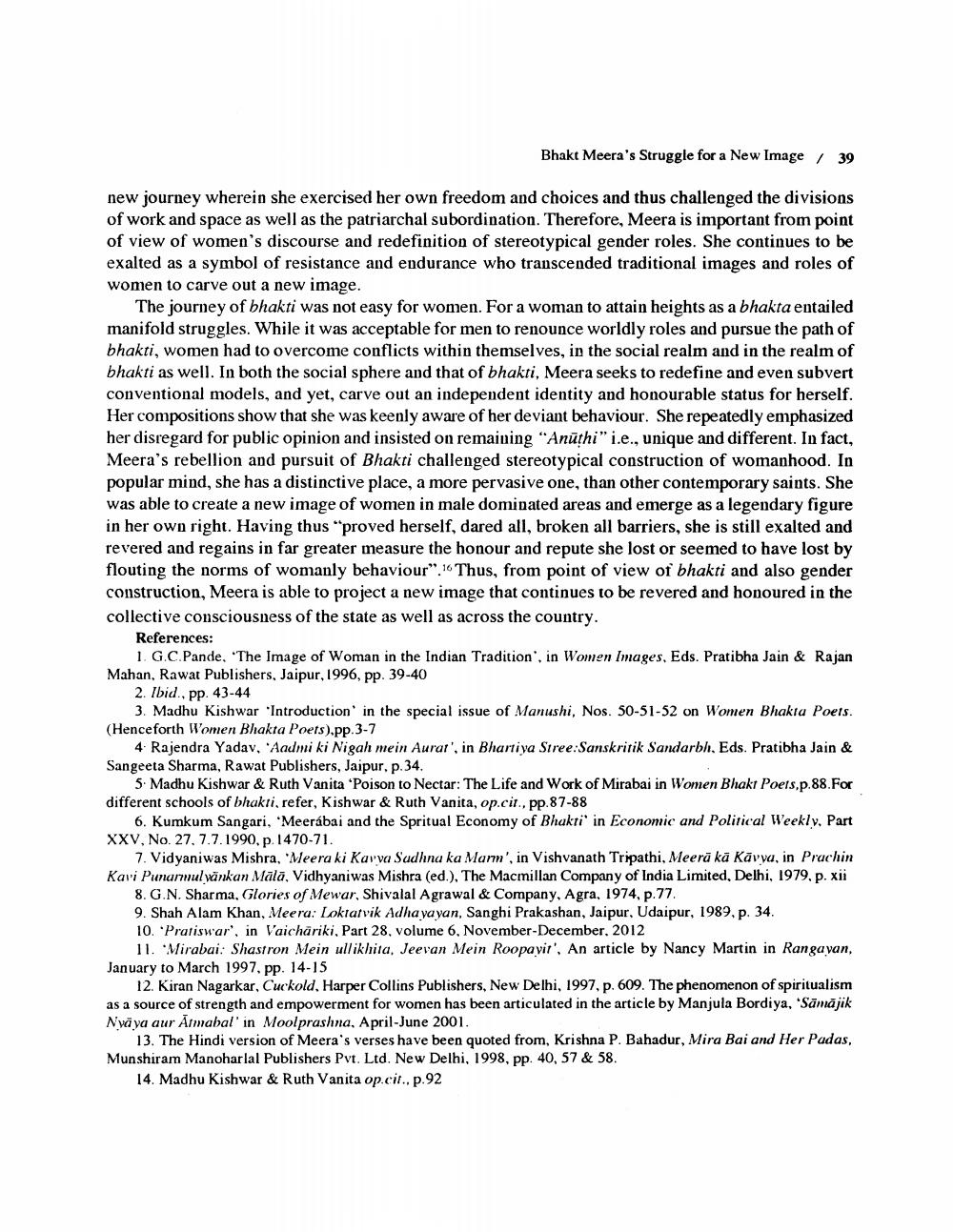________________
Bhakt Meera's Struggle for a New Image / 39
new journey wherein she exercised her own freedom and choices and thus challenged the divisions of work and space as well as the patriarchal subordination. Therefore, Meera is important from point of view of women's discourse and redefinition of stereotypical gender roles. She continues to be exalted as a symbol of resistance and endurance who transcended traditional images and roles of women to carve out a new image.
The journey of bhakti was not easy for women. For a woman to attain heights as a bhakta entailed manifold struggles. While it was acceptable for men to renounce worldly roles and pursue the path of bhakti, women had to overcome conflicts within themselves, in the social realm and in the realm of bhakti as well. In both the social sphere and that of bhakti, Meera seeks to redefine and even subvert conventional models, and yet, carve out an independent identity and honourable status for herself. Her compositions show that she was keenly aware of her deviant behaviour. She repeatedly emphasized her disregard for public opinion and insisted on remaining "Anuthi" i.e., unique and different. In fact, Meera's rebellion and pursuit of Bhakti challenged stereotypical construction of womanhood. In popular mind, she has a distinctive place, a more pervasive one, than other contemporary saints. She was able to create a new image of women in male dominated areas and emerge as a legendary figure in her own right. Having thus "proved herself, dared all, broken all barriers, she is still exalted and revered and regains in far greater measure the honour and repute she lost or seemed to have lost by flouting the norms of womanly behaviour". 16 Thus, from point of view of bhakti and also gender construction, Meera is able to project a new image that continues to be revered and honoured in the collective consciousness of the state as well as across the country.
References:
1. G.C.Pande, 'The Image of Woman in the Indian Tradition', in Women Images, Eds. Pratibha Jain & Rajan Mahan, Rawat Publishers, Jaipur, 1996, pp. 39-40
2. Ibid., pp. 43-44
3. Madhu Kishwar 'Introduction' in the special issue of Manushi, Nos. 50-51-52 on Women Bhakta Poets. (Henceforth Women Bhakta Poets),pp.3-7
4 Rajendra Yadav, Aadmi ki Nigah mein Aurat', in Bhartiya Stree:Sanskritik Sandarbh, Eds. Pratibha Jain & Sangeeta Sharma, Rawat Publishers, Jaipur, p.34.
5. Madhu Kishwar & Ruth Vanita 'Poison to Nectar: The Life and Work of Mirabai in Women Bhakt Poets,p.88.For different schools of bhakti, refer, Kishwar & Ruth Vanita, op. cit., pp.87-88
6. Kumkum Sangari, 'Meerábai and the Spritual Economy of Bhakti' in Economic and Political Weekly, Part XXV, No. 27, 7.7.1990, p. 1470-71.
7. Vidyaniwas Mishra, 'Meera ki Kavya Sadhna ka Marm', in Vishvanath Tripathi, Meerā kā Kāvya, in Prachin Kavi Punarmulyankan Mālā, Vidhyaniwas Mishra (ed.), The Macmillan Company of India Limited, Delhi, 1979, p. xii
8. G.N. Sharma, Glories of Mewar, Shivalal Agrawal & Company, Agra, 1974, p.77.
9. Shah Alam Khan, Meera: Loktatvik Adhayayan, Sanghi Prakashan, Jaipur, Udaipur, 1989, p. 34.
10. Pratiswar', in Vaichāriki, Part 28, volume 6, November-December, 2012
11. Mirabai: Shastron Mein ullikhita, Jeevan Mein Roopayit', An article by Nancy Martin in Rangayan, January to March 1997, pp. 14-15
12. Kiran Nagarkar, Cuckold, Harper Collins Publishers, New Delhi, 1997, p. 609. The phenomenon of spiritualism as a source of strength and empowerment for women has been articulated in the article by Manjula Bordiya, 'Sāmājik Nyaya aur Atmabal' in Moolprashna, April-June 2001.
13. The Hindi version of Meera's verses have been quoted from, Krishna P. Bahadur, Mira Bai and Her Padas, Munshiram Manoharlal Publishers Pvt. Ltd. New Delhi, 1998, pp. 40, 57 & 58.
14. Madhu Kishwar & Ruth Vanita op.cit., p.92




